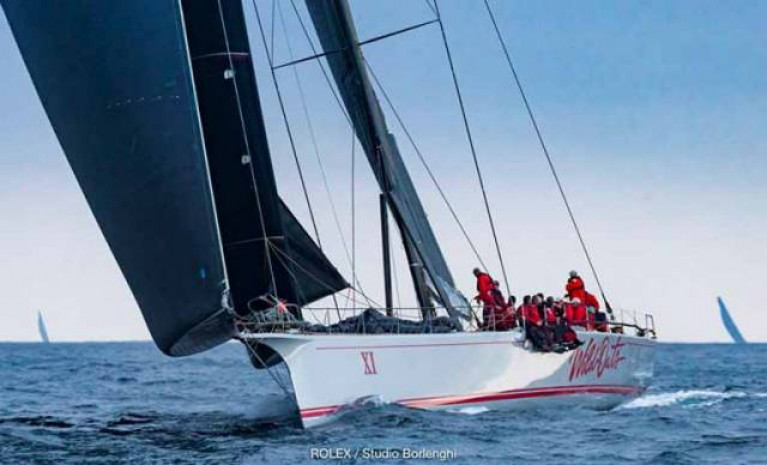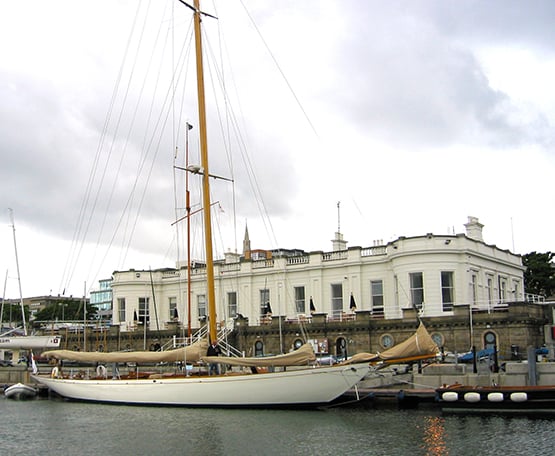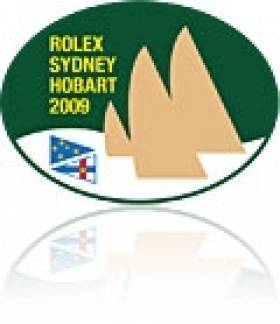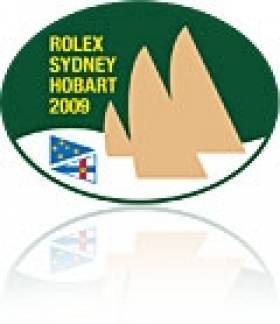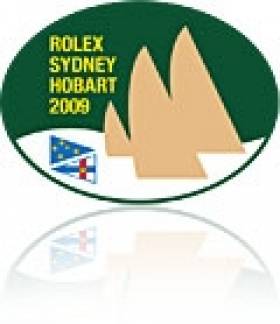Displaying items by tag: Wild Oats XI
Big Names Bow Out of 2020 Rolex Sydney Hobart
While this year’s Rolex Sydney Hobart has been given the go-ahead after lengthy consultation, at least two big names won’t be joining the 100-strong fleet next month.
Sailing Anarchy reports that the legendary 100-footer Wild Oats XI will remain in storage for the start on 26 December — the first time in 16 years that the Reichel-Pugh won’t compete in the annual blue water classic.
And Wild Oats’s arch rival Scallywag has withdrawn from the race, reportedly because owner Sen Huang Lee and a number of crew were unwilling to meet the mandatory two-week quarantine for all racers entering Australia from abroad.
With these two giants of the race now out of the picture — leaving only two 100-footers, Black Jack and InfoTrack in contention — could this spell the end of the dominance of the supermaxis? Sailing Anarchy has more on the story HERE.
The Legendary Start For Sydney’s Headlong Rush To Hobart
There’s nothing that really compares with the annual Rolex Sydney Hobart Race. While most of the more-populated parts of the world in the Northern Hemisphere are in their midwinter shutdown, somnolent and sluglike in a festival of consumer excess, away south of the Equator one of the most magnificent city harbours in the world is exuberantly celebrating outdoors in all its midsummer glory. And then it tops out the party with one of world sailing’s great spectacles. W M Nixon anticipates the Rolex Sydney Hobart Race 2015, which starts in full daylight in Australia an hour after this is posted at midnight on Christmas Day in Ireland.
With the Yuletide festivities scarcely put away, a group of extreme boats at the peak end of the hundred foot size limit - every last one of them owned and sailed by larger-than-life characters – comes roaring out of Sydney’s glorious harbour at the head of a magnificent fleet, a colossally varied collection of 108 craft in which every crew reckons they’re in with a chance. For although line honours for the biggies are what captures the headlines, for the dyed-in-the-wool enthusiasts the only real trophy in the thrash to Hobart is the Tattersall’s Cup for the overall winner on IRC Handicap.
A severe weather forecast of three days ago has now been watered down, but there’ll still be plenty of breeze at some stages to be going along with. The start is expected to be in a moderate to fresh northeasterly, stronger outside once they begin making southing down the Tasman Sea, with most boats chasing that elusive race-winning south-going current which may be anything up to ten miles offshore.
Then everything changes in the weather situation with an active front rolling up from the south and southwest, with strong headwinds – maybe gusting to 45 knots in the front itself – providing atrocious wind-over-tide conditions with the under-lying south-going current. There’ll be a lot of Christmas dinners spread out over the ocean……After that, the winds are forecast to fall away as the bulk of the fleet get to the Bass Strait, but overall the pundits are reckoning boats in the 60ft to 75ft size range are looking to be the favoured cohort, while George David’s Rambler 88 – with the legendary Brad Butterworth in the afterguard – is now looking good to give the hundred footers more than a few tense moments.
By the time you’re likely to be reading this on Saturday morning, the drama will already be unfolding on the other side of the world, and all sorts of newsfeeds will be available for the best armchair offshore racing of the year. Yet as a Rolex Sydney-Hobart Race addict, I’ll readily concede that the last thing addiction provides is a clear picture, so you can expect this anticipation to be something of a rose-tinted view.

The Rolex Sydney-Hobart Race – a classic course which is staging its 71st edition as 2015 draws to a close
But that said, the Rolex Sydney Hobart Race of 2014 will take some beating. It provided the glorious battle for line honours between the new Comanche and the continually-evolving Wild Oats XI, veteran owner and local favourite Bob Oatley’s originally 98ft Reichel Pugh Wild Oats XI of 2005 vintage, but modified almost every year since, such that by December 2014 she was a hundred footer. Against her, the big new fat girl, Jim and Kristy Hinze Clark’s JK-designed total hundred footer Comanche, so big and beamy you could fit two Wild Oats into her and still have room to spare.
Yet although all the heavy metal seemed to be on Comanche’s side, including having the formidable Kenny Read as skipper, in the end the skinny girl wriggled her way through some awkward conditions which Comanche loathed, and wriggled to such good effect that Wild Oats took line honours.

It’s reckoned you’d still have room to spare after fitting two of Wild Oats XI (left) into the very different hull of Comanche (right)
And then, to put the icing well and truly on the Hobart cake, as the various potential handicap winners were knocked out by the remorseless ticking of the clock, an overall winner emerged who was the very epitome of the true Australian ocean racing spirit. The veteran Farr 43 Wild Rose, owned successfully for many years by Roger Hickman, was on top of her immaculate form, and won the Tattersall’s Cup.
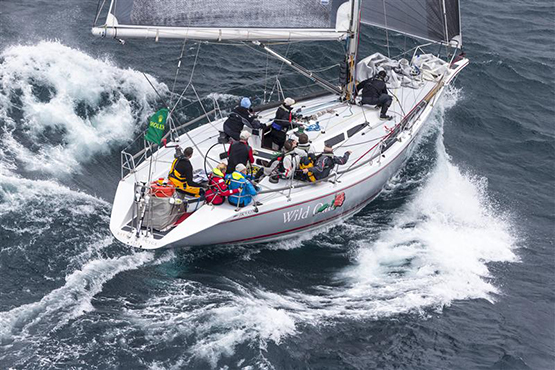
The true spirit of Australian offshore racing – Roger Hickman’s 28 year old Farr 43 Wild Rose (ex-Wild Oats) is defending champion in this year’s Rolex Sydney-Hobart race
And what was Wild Rose’s back-story? You just couldn’t make it up. She was one of the first boats to be called Wild Oats, brought to the Australian racing scene by a legendary entrepreneur called Bob Oatley who’d been so successful in business in Papua New Guinea that at one stage he was controlling 95% of the entire country’s GDP. And then, when local interests bought him out, he shifted operations back home to Australia, and created himself a new conglomerate business empire on an even large stage.
He found that the challenge of campaigning a serious offshore racer at the top end of the exuberant Australian offshore racing scene went perfectly with business. If the boat did well, enterprises like Robert Oatley Wines did well too. But regardless of that, it was fun. So although he’s looking into his 90s. Old Bob is as keen as ever on the whole crazy game, and with Mark Richards he has the perfect skipper/boat manager to maximize returns from the sheer entertainment provided by keeping Wild Oats XI up to the mark to fulfill her role as the people’s favourite.
The improvement project for 2015 was basically to re-position the mast. Now most folks, if they decide the mast is too far forward, they’d simply move it aft. But not the Wild Oats team. At its most fundamental, what they’ve done is keep the mast where it was, but they chopped off the bow - the chainsaw pix say it all - and then added a completely new longer slimmer bow. Try as you might, you can’t see the join…...

If you’re going to take the bow off the boat with a chainsaw, better make sure you’ve the owner there to do it with you. Mark Richards and Bob Oatley start the drastic surgery on Wild Oat XI
 You can’t even see the join….,Wild Oats with her new longer bow (right) with the old bow (left) kept in storage “in case the new one didn’t work” . But would you call that new stem a “clipper bow”?
You can’t even see the join….,Wild Oats with her new longer bow (right) with the old bow (left) kept in storage “in case the new one didn’t work” . But would you call that new stem a “clipper bow”?
Then, to keep her down to a hundred feet, they shortened and re-shaped the stern, such that the result of it all is the skinny girl is now super-slim. But thanks to the latest materials and some ferociously clever engineering and technology, Wild Oats is able to carry a mighty canting keel which keeps this torpedo of a boat upright and powering successfully along, in which mission she is further assisted by all sorts of canards and foils which can be deployed from multiple orifices.
Central to the whole story today, however, is the fact that the Hobart Race 2015 is the first real test of the completely re-vamped Wild Oats XI, and she’s yet again up against Comanche as a trial horse. But after such radical changes, naturally there are those who’ll question them. For a start, it has been noted that with the completely new bow section, the even longer bowsprit on WOXI is receiving additional support from a sort of solid strut from the stem which creates what some of us might describe as a clipper bow.
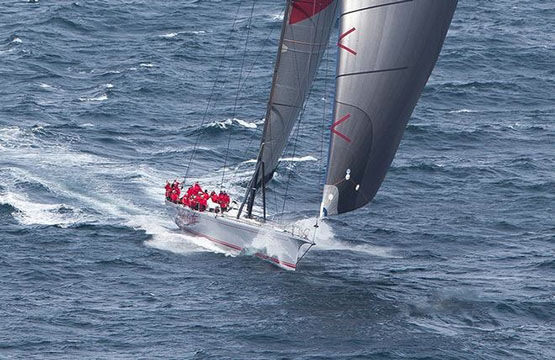
The re-configured Wild Oats XI is faster than ever, but what length is she?
And if you accept that this has indeed become a clipper bow of sorts, instead of a straight stem bow which happens to have a solid strut support for an unusually long bowsprit, then you’re accepting that Wild Oats’ hull has now become more than a hundred feet long, and therefore above the size limit for the Rolex Sydney-Hobart Race. At the time of writing, the Race Committee seemed to have accepted that Wild Oats still has a straight stem. But we can think of a few sea-lawyers who might possibly demur.
In the end, it’s a matter of definitions. Just recently, a Classic Boat magazine profile of the magnificent Fife-designed-and-built 1926 Fastnet Race line honours winner Hallowe’en revealed she is just over 71ft LOA, and something like 47ft when unladen on the waterline. The waterline length was fine, as it allowed some immersion in seagoing trim to stay within the Fastnet limit of 50ft LWL. But what’s with this 71ft plus in the LOA department, when the Fastnet Rule – set after the inaugural race of 1925 – clearly set the upper LOA limit at 70ft? Well, it seems that Hallowe’en is 70ft LOA on deck. And LOD was seen by many as being one and the same thing as LOA back in 1926. So now you know.
Hallowe’en, 1926 Fastnet Race Line Honours Winner, at the Royal Irish YC. While she was 70ft LOD to comply with the Fastnet Race maximum size, her hull LOA is actually slightly north of 71ft. Photo: W M Nixon
Whatever, this morning the one thing we’re starting to know is just how well the new-style Wild Oats is going, as there’s plenty of wind forecast for some stages, and the only test so far against other boats was in smooth water conditions in the Solas Big Boat Challenge a fortnight ago. This was a 14 mile round-the-buoys sprint within Sydney Harbour in which George David’s Rambler 88 was still right there with Wild Oats at the weather mark, but thereafter the Oats lengthened away in impressive style, while the other hundred footers weren’t really in contention with either her or Rambler.

Racing in the Solas Big Boat Challenge on Sydney Harbour a fortnight ago. The new look Wild Oats XI is already showing ahead, but she had quite a job to shake off the smaller Rambler 88 (second right). There’s a lot of sailing history in this photo. Perpetual Loyal (second left) was formerly George David’s Rambler 100 which capsized at the Fastnet Rock in 2011 after snapping off her keel.
But of course Comanche very sensibly stayed away from the Solas Big Boat Chalenge. In-harbour contortions aren’t her thing at all. The big wide boat needs the wide open spaces of the clear ocean and the challenge of the 628 miles to Hobart. So it’s right now that the two monsters in their current form are at each other’s throats for the very first time, like a giant rattlesnake against a huge python. Jurassic Park goes sailing…….
After the hors d’euvre of the line honours battle, we then re-focus on the body of the fleet for the main course, and on the race tracker it’s fascinating to watch as fortunes wax and wane for different groups. But within each group, regardless of how they’re doing within the fleet at large, as the race progresses the group leaders become more clearly defined, but quite why and where it happens is sometimes only discernible in the post-race analysis.
For instance, last year the Dun Laoghaire crew of Barry Hurley and the Rumball brothers were right there on their First 40 with the comparably-rated Wild Rose as they approached the Bass Strait. But then with a couple of twists and turns of fortune Wild Rose got herself into a better rhythm, and there she was – gone – while the Irish crew slipped in the rankings.
The top Irish skipper within class in 2014 was Sean McCarter in the Clipper Division with Derry/Londonderry/Doire - he won the Clippers as they took it in as part of their multi-stage race round the world. The Clippers are there again this year in what is the most international fleet yet seen in the Sydney-Hobart, with a first-time strong mainland Chinese representation, particularly through Ark 323, their TP 52 whose home club is the Noah Sailing Club. If they do well, we can hope to find out how a challenger from the People’s Republic seems to draw so heavily on the Old Testament for the names of boat and club alike.

Will she finally find her true form? The Carkeek 60 Ichi Ban (Matt Allen), raced by Gordon Maguire, is in the size cohort favoured by the pundits to suit the forecast wind and weather.
Our own Gordon Maguire, winner overall in 1991 and 2012, is going again, and again it’s on Matt Allen’s Carkeek 60 Ichi Ban, which has a new rudder and other mods, and has been showing an improvement in form. And we now know that Maguire is going with the Carkeek 60 which is called Ichi Ban. Because you see, Matt Allen happens to have a TP 52 which is also called Ichi Ban, and though the modified Carkeek 60 seemed to have found better form to win the Cabbage Tree Island race at the end of November, even then Allen wouldn’t say which Ichi Ban would do the Hobart Race. But with the wind pattern forecast, it will be the Carkeek, indeed she is now rated one of the favourites if the weather does as the gurus say it will.
Another boat of special Irish interest is the completely new Wicklow-designed Mills 45 Concubine, built in Dubai for South Australian sailor Jason Ward of Adelaide, and only afloat since November 11th. So she has scarcely been sailing seriously for much more than a wet week. But the word is the boat’s potential is enormous. And simply seeing how she performs in this ultimate test tank of modern middle distance offshore racing is going to be top of the interest levels for the next few days.
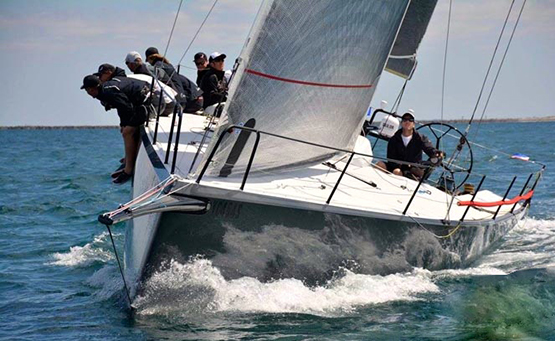
Her lines were drawn in the midst of the Wicklow countryside – the new Mark Mills-designed 45ft Concubine will have her first real test in the Hobart Race
For although the Hobart Race is of rather more recent date than the other classics such as the Bermuda Race and the Fastnet, they are biennial whereas the Sydney-Hobart has been an annual event ever since being founded in 1945, and thus has built up its mystique more quickly. As a result, some devotees log up an astonishing number of races to Hobart, and this year Tony Cable will be doing his 50th . This time round – as it has been for the past four Hobarts – he’s aboard Damien Parkes’ JV52 Duende, but he has been on many different boats, and in all he has raced to Hobart with 308 different crewmates over the years, so they’re going to need a very large premises for his reunion.
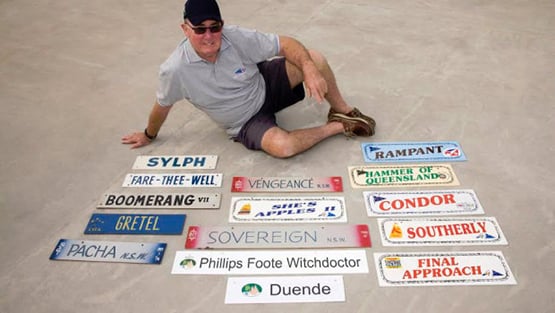
Tony Cable is doing his 50th Sydney-Hobart Race – these are the name plates of the 15 boats he has sailed on
The Sydney-Hobart Race started at the end of World War 2 when Sydney cruising men asked the great offshore racing legend Captain John Illingworth RN – who happened to be running the navy yard at Wooloomoolo at the time – if he’d be interested in a cruise-in-company down to Hobart over Christmas. He said he’d be interested in the offshore passage to Hobart, but only if they made it a race.
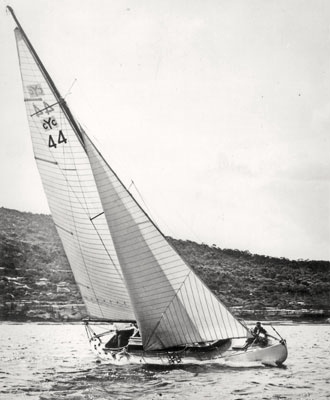
Rani (John Illingworth) was winner of the first Sydney-Hobart race in 1945
By the time it got going, he’d acquired himself a little locally designed and built sloop called Rani. Despite having one of the smallest boats in the fleet, Illingworth battled on through a proper Southerly Buster and then another gale, before he finally got to Hobart expected to be dog last in this new race, as Rani’s radio had packed it in shortly after the start. Thus they’d no word of anyone else at all, while they themselves had been posted missing.
But he found he was twenty hours ahead of the next boat on the water. He’d won overall by hours or even days, and it was a long time before all the fleet had got in. Every other entry had sought shelter of some sort. And one boat had even gone into port so that her crew could go to the cinema to pass the time before racing on south once the weather had improved. Be assured that things are different these days in the Rolex Sydney-Hobart Race
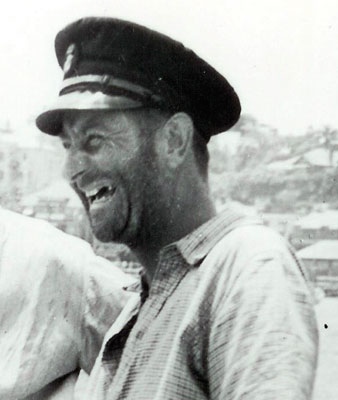
Captain John Illingworth looking more than somewhat weatherbeaten at the finish of the first Hobart race in 1945, which he won. He went on to win the Fastnet Race overall twice (in 1947 and 1949) with Myth of Malham.
Wild Oats XI Takes Record Eighth Sydney–Hobart Win
#rshyr – Wild Oats XI has secured a record eighth line honours victory in Australia's Sydney–Hobart Race.
"This is the sweetest victory by far," Wild Oats XI skipper Mark Richards declared today after steering the silver-grey thoroughbred to the historic win.
"To rewrite a bit of sailing history doesn't come along every day. To win a Hobart is a great honour but to win an eighth; I can't believe I am here," Richards said.
"It's been the hardest win," owner Bob Oatley added. "Comanche is an exceptional yacht, probably the most expensive yacht ever built. A wonderful boat. When she took off at the start of the race I was amazed."
"Comanche was unbelievably impressive down Sydney Harbour," Richards said, "and the whole first night she had the legs on us. We thought, 'how are we going to handle this thing'?
"It was definitely our toughest race. To have a boat so close for so much of the race, especially when she's faster than you. I said to the guys 'we've got to hang in there, hang tough, minimise our losses and wait for the first opportunity we get to attack'.
The break came on Saturday morning in the middle of Bass Strait. Gone were the fresh conditions of the first day, ahead loomed a ridge of high pressure sweeping between the mainland and Tasmania; a wall of light air that would define the 2014 Rolex Sydney Hobart.
Get through the gate in time and there would be a light breeze, but a breeze nevertheless. Get caught on the wrong side and face a purgatory of calm. Wild Oats XImade the closing gate and, at last, found the lighter conditions that so suited her. She steadily pulled away from Comanche, opening up a 40 mile lead.
"It was a race to get through that gate from three days before the race," when the Bureau of Meteorology warned the competing crews of the looming ridge at the pre-race briefing at the Cruising Yacht Club of Australia, said Wild Oats XI's tactician Iain Murray.
"Luckily for us, we just got through the gate. Comanche got there too, but they were slow out of it. We did really well to hang onto them in the rough stuff and still be side by side with her on Saturday morning, and then it was our turn."
"It was a race to get past the ridge," Richards agreed, 'that was the whole thing. They actually slowed us down in the light weather. We went to leeward of them, but couldn't get past, so we ended up taking a big pill, lost some ground to get to weather of them. But eventually it paid off, we got past them and away we went."
The nine year-old slim Wild Oats XI, designed by Reichel/Pugh and built by McConaghy, is faster in light airs than the more powerful wider and heavier Comanche.
Oatley's yacht was in her element in Bass Strait. But as the winds built up again this morning, the balance swung back in favour of the big American. As the pair raced down the Tasmanian coast she gradually reeled Oats back in. But with lighter air forecast in Storm Bay, Richards remained confident.
"It was inevitable that they would gain on us," Richards said, "but we knew that once they got us they wouldn't get past us. We finished in our perfect conditions."
So is it official now? Is Wild Oats XI one of the greatest Sydney Hobart yachts of all time, alongside the likes of Solo,Astor, Kurrewa IV, Kialoa and Condor of Bermuda?
"Just look at the record," Richards beamed, "she'll go down as one of the legends of the race."
Can she stay at the top? Every year there have been major innovations made to the boat to keep her competitive. Are there more modifications to the 10-year-old boat to come?
"She always needs something," Bob Oatley laughs, "she is a very expensive girl to look after."
"There's not a lot left we can do to this boat other than to sail it well," Iain Murray says. "It is a great all-round boat. Clearly it has an advantage over the newer boats in light winds and it's up to us to sail the boat in stronger winds as best we can and minimise the damage."
Follow the race on the live tracker here.
Sydney–Hobart Fleet Leaders Reach Halfway Stage
#rshyr – The chase for line honours at the 2014 Rolex Sydney Hobart Yacht Race is intensifying with the leading boats approaching the halfway mark of the 628-nm Australian offshore race. In the IRC handicap race, the part Irish–crewed Breakthrough Beneteau 40 is currently third lying overall.
The Barry Hurley led team is the best placed boat of Irish interest. Pam Lee from Greystones on Balcksheep is 16th and Dublin sailor Keith Hegarty on Merlin is 41st. Howth's Gordon Maguire on Ichi Ban is 61st. See overall handicap leaderboad here.
At 16:00 local time and 27 hours into the race, the Mark Richards-skippered Wild Oats XI lay 13 nautical miles ahead of Comanche - the American Maxi which had led the race for 22 hours following a blistering exit out of Sydney Harbour. Wild Oats XI is chasing an unprecedented eighth line honours victory, Comanche hoping to triumph in her first offshore race.
"Last night we had some big seas, so it was fairly sloppy on a wide boat like this. It was a bit of a challenge," reported Comanche navigator Stan Honey, line honours winner on Investec Loyal in 2011. "The real challenge will come later tonight and early tomorrow morning when it gets light off the southeast corner of Tasmania." Indications suggest that the 2014 race will be go down to wire, won or lost in the Derwent River.
Syd Fischer's Ragamuffin 100 currently lies sixth on the water, a significant 50-nm behind the leading two boats, although sailing master David Witt was confident of narrowing that gap. Ragamuffin has chosen a different route, closer to the rhumb line. "The two leaders are going to stay together. I think we are going to meet them at the Tasman lighthouse. It's going to be light, so it's going to suit both Wild Oats XI and ourselves."
117 yachts started the race, eight have retired - the most high profile remains Anthony Bell's 100-ft Maxi Perpetual Loyal, forced to abandon the race with hull damage sustained during the first evening. It represented a huge blow for Bell who won line honours with Investec Loyal, his previous boat, in 2011. Other retirements include Brindabella, Last Tango and Triton.
While the leading Maxis are forecasting arrival in Hobart during the afternoon tomorrow, beating the race record of 1 day, 18 hours, 23 minutes and 12 seconds set by Wild Oats XI in 2012 is likely to remain an illusion.
For the 109 yachts still at sea, a testing measure of endurance sailing awaits. Race tracker HERE
Sydney–Hobart Yacht Race Start Video, Comanche Leads Fleet After Seven Hours
#rshyr – Seven hours into the 2014 Rolex Sydney Hobart Yacht Race, Jim Clark's 100-ft Maxi Comanche (USA) leads the fleet. A memorable edition of the 628-nm race appears certain, with the contest between the fleet's five Maxi yachts living up to the pre-race hype.
At 8:00pm local time, Comanche leads seven-time line honours winner Wild Oats XI by one nautical mile, with Anthony Bell's Perpetual Loyal and Syd Fischer's Ragamuffin 100 just a few miles behind the leading duo. Overnight the breeze is forecast to lighten as a high pressure system approaches. How the frontrunners navigate this transition could be a critical factor in their race.
Comanche makes mark
A fleet of 117 international yachts graced today's Rolex Sydney Hobart Yacht Race start. The thousands of spectators lining the shoreline in Sydney were treated to a dramatic start as the leading yachts powered their way out of Sydney Harbour and began the famous 628-nautical mile offshore race to Hobart.
Celebrations for the 70th edition of the race commenced with a Parade of Sail of historic Rolex Sydney Hobart competitors before the race start. A fitting tribute to the race, which has become an international icon since its inauguration in 1945.
Comanche had an incredible start reaching the first course mark at record speed. Race record holder Wild Oats XI gallantly tried to keep pace, watching in awe as Comanche laid down an early indicator of her potential. "Look at that thing go!," screamed Wild Oats XI skipper Mark Richards.
"We couldn't be more ready at this stage," admitted Comanche skipper Ken Read shortly before the race start. "The team has done a Herculean effort to get the boat ready. We are here to compete, it's the fun part of our job."
"Going into a southerly the first night is always a bit of a challenge," said Mark Richards going into the race. "(The boat) being ten years old though is a little bit of an advantage for us as we know the boat very well."
Shortly after the start, Peter Isler, navigator on Manouch Moshayedi's RIO 100 reported: "We are definitely learning our boat in these conditions. It's very rough, sailing upwind in 25-27 knots, pounding hard into short, steep waves."
The rough conditions have proved demanding for a number of the fleet with four retirements already recorded.
The race record for leading yachts to beat is 1 day, 18 hours, 23 minutes and 12 seconds, set by Bob Oatley's Wild Oats XI in 2012.
For Irish Offshore Racing Sailors, 'Tis The Season To Be Sailing To Hobart
#rshyr – Tasmania is a medium-sized island in the Great Southern Ocean which is sheltered to the west only by South America. And as Tasmanians reckon skinny little New Zealand doesn't really provide a proper lee, they'll tell you their island is also sheltered to the east only by South America. So although it is at the same latitude in the south as Bordeaux in southern France is in the north, Tasmania's weather conditions – particularly the winds – can be much more extreme than they are in Bordeaux.
For sure, this lovely island can have some beautiful summer weather. But equally, it can serve up some very demanding sailing conditions. Thus the annual 628-mile Rolex Sydney-Hobart Race inevitably brings the fleet into increasingly hostile seas the further south they progress down much of the course. And the Bass Strait between Australia and Tasmania is a notoriously rough bit of water which has claimed lives in this event.
But then the twist in the tail is the final ten or so miles from the Iron Pot up the narrowing and increasingly flukey Derwent Estuary to the finish at the Hobart waterfront. This concluding crawl can test any sailor's sportsmanship as he or she sees a good position, hard earned over hours and days on a very rough sea, wafted away in calm spots and fickle zephyrs. Indeed, some hardened Hobart race veterans reckon the real contest finishes not even at the Iron Pot, but rather as you enter Storm Bay in the approaches to the Derwent Estuary, saying that it's just a lottery thereafter. But despite such criticisms, the race is one of sailing's great events. W M Nixon takes a look at this year's 70th staging of the classic, which starts in traditional style on Sydney Harbour in less than six days time.
If the annual Rolex Sydney-Hobart Race didn't exist, then world sailing would have to invent it. But happily, it's there already for our absorption and enjoyment. And in 2014 for its 70th staging, it's more relevant than ever in an era of instant global communication. When we remember that much more than half of humanity lives in the Northern Hemisphere and many of them are now in the depths of winter, the fact that there's this glorious and accessible sailing spectacle all ready to roll on screens worldwide, just as we're finally sated with Christmas and all its trappings, is a sanity-preserver for anyone interested in boats and sport.
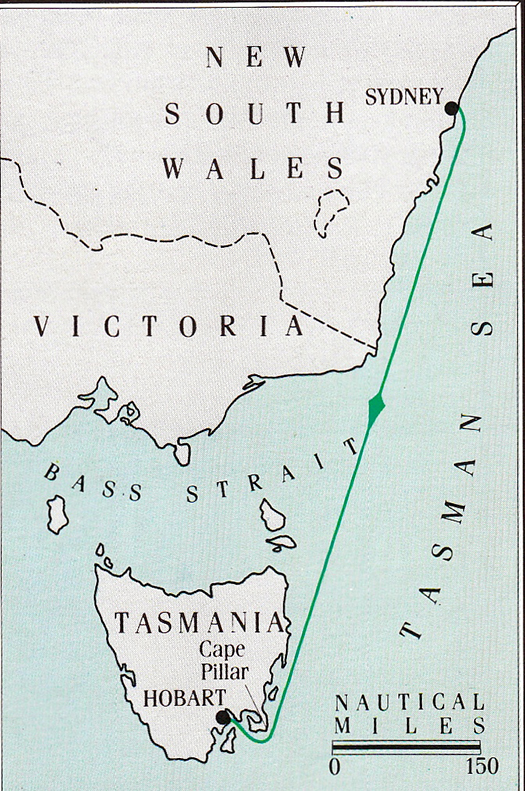
The great race's 628 mile course takes the competitors ever deeper towards the Southern Ocean with every mile sailed.
Of course there's Irish involvement in it at a specific level, with two boats in particular carrying our special interest. But at a more generous level, anyone who has the slightest interest in sailing cannot but be fired up by the wonder of an event in which some of the most advanced hundred footers in the world are swept up in a contest in which they will not only be in cut-throat competition with each other for line honours, but at the end, when all the calculations have been done, for dyed-in-the-wool offshore racing enthusiasts the real competition will be for the Tattersall's Cup, the hugely prestigious trophy for the overall handicap winner.
With 117 expected starters of all sizes from 33ft to 100ft, as the race gets under way each boat will have its own ideal set of conditions and circumstances to suit crew hopes. But as the contest continues, there'll be those who start to emerge in the leading group on handicap, and by the time they're in the final approaches, it is usually whittled down to about a dozen boats or even less which are in there with a shout for the Tattersall's.
But the line honours race for the Illingworth Cup – named in honour of the great British offshore racing skipper and innovator John Illingworth who first suggested the race in 1945 and won it too – now that's a different animal altogether. It's a real death or glory battle. And there's something specially entertaining and attractive about a no-holds-barred contest between boats you could like a lot, just at the time when the word is that the current flotilla of Volvo Round the World Racers may not be very likeable boats at all.
For we hear that the Volvo 65s are twitchy beasts, and not really fun to sail. To have a boat which turns round and looks at you is unfortunate. To have a boat which lies on its back and waves its legs in the air is unfortunate. But a boat that does both....? Oscar Wilde's Lady Bracknell said everything about such a situation.
So we'll return with relief to the crazy guys with the glorious big boats at the front of the fleet in the race to Hobart, for after the Volvo 65s, they're like a breath of fresh air. This is definitely not the territory of careful accountants and penny-pinching save-a-dime boatbuilding. We're looking at the stuff of legend. And the people's favourite has to be the veteran Wild Oats XI, marvellously campaigned by Mark Richards and his team of all the talents with the full support of the veteran owner Bob Oatley (86), whose wine brand of Wild Oats – one of many business interests – doesn't suffer any image problems at all when his boat of the same name wins yet again.
They talk of the Reichel Pugh designed super-slim Wild Oats XI as a "beloved old boat", but in truth she has been so continuously modified that you'd be hard put to say just what is original. The word is they've made her waterlines even narrower up forward – she used to be skinny, but now she's anorexic. As for last year's secret ingredient, the horizontal hydrofoil which, when deployed to lee, reportedly improved performance by up to 4% by making the boat better able to carry sail, for this year's race they tried making it even longer, such that it didn't entirely retract into the housing. But it seems that with a bit sticking out permanently on the weather side, it created more fuss than it was worth, so it has been shortened back to disappear entirely when not in use.
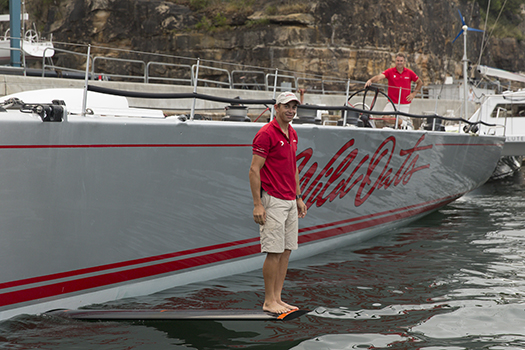
Wild Oats XI has so many bits and pieces sticking out of her hull that she has been compared to a Swiss Army Knife. This is skipper Mark Richards standing on the horizontal hydrofoil which, when deployed on the lee side, gives sufficient lift to significantly improve sail-carrying power. However, it has been shown that it has to be completely retractable into its housing when on the weather side, otherwise it causes unacceptable turbulence.
This conclusion on the downside of making the hydrofoil even longer emerged from some serious heavy weather sailing by Wild Oats off Sydney recently, when she was getting her final pre-Hobart race test and crew training. Heading back to port, with only about a quarter of the mainsail set in a very big wind, the silver arrow was making up to 33 knots. That will be food for thought for the four other hundred footers, the most challenging of which is of course Jim and Kristy Hinze Clark's new Comanche, just out of the wrappings, a hundred foot of total racer with Kenny Read as skipper.
The new girl on the block. American Jim Clark and his Australian wife Kristy Hinze Clark will debut their new hundred footer Comanche in the Rolex Sydney-Hobart 2014.
The same Kenny Read endeared himself to the Irish sailing community during the first Volvo visit to Galway five years ago, when he exited the dock somehow managing to look cool wearing a Paddy Hat that no-one else would be seen dead in. The boy is still busy, as he's worldwide president of North Sails, while his current main commitment afloat is to campaign the very extreme Comanche to the limit, with the Rolex-Sydney Hobart Race 2014 the first outing for real.

God be with the days.....five years ago, Kenny Read endeared himself to the people of Ireland by managing to look cool in this hat while exiting Galway Docks during the Volvo stopover. Photo: Failte Ireland/David Branigan
The hundred footers did have their first encounter a couple of weeks ago with the CYCA Solas Big Boat Challenge in Sydney Harbour, but racing boats this size in such relatively restricted water gives a somewhat skewed picture. Nevertheless the very experienced tacticians on Wild Oats still managed to finish first, as they did last year, but it was Comanche second quite a bit clear of Anthony Bell's Perpetual Loyal.
Once upon a time, Perpetual Loyal was very well known in Ireland, but that was in 2011 when she was George David's Rambler 100, and upside-down off West Cork. Until Comanche's appearance, Perpetual Loyal was reckoned the potentially fastest hundred footer of them all if she just could get enough wind in the right direction. But now the hundred footer field is wide open as a number of them have been undergoing major modifications of the kind you might expect to see on model yachts, but not on thirty metre hulls.

Can you see the join? The entire aft half of Rio 100 is entirely new, thanks to several months of major surgery in Auckland.
Thus the former Lahana, now American-registered, owned by Manouch Moshayedi and re-named Rio 100, simply had her entre aft half cut off, and replaced with a new wider stern section. Just like that. But you ain't heard nuthin' yet. The irrepressible Syd Fischer, shaping up to do his 50th Sydney-Hobart at the age of 87, decided that the hull of his hundred foot Ragamuffin needed some mods. A lot of mods. So he has just kept the deck and rig, but cut off the original hull, and replaced it with a new one from the same designer, Andy Dovell.
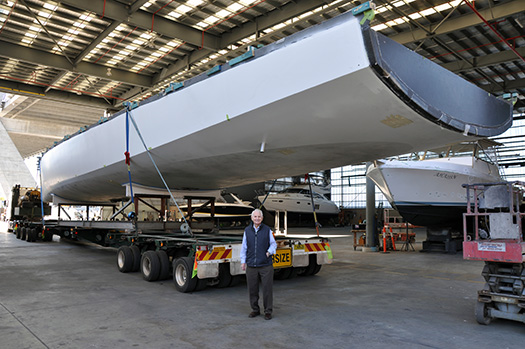
The incredible Syd Fischer, a sprightly 87-years-old, with the entirely new Andy Dovell-designed hull before it was fitted under the deck and rig of his previous hundred footer Ragamuffin.
So if next time you're on Sydney Harbour and a peculiar-looking hundred foot motorboat comes tootling past with a slightly lost air to her, you'll know why. She could swear that once upon a time she had a deep keel and a great big mast. But she's out and motoring about because there's no way Australians will let a redundant hundred foot hull go to waste. Meanwhile, the new raceboat hull has barely had time for testing, but we're assured all will be well, and the something old, something new Ragamuffin 100 will be there on the line raring to go against Wild Oats, Comanche, Perpetual Loyal and Rio 100 in the battle for line honours.
But as old Hobart hands will tell you, the real race is almost something else altogether. You'll have noticed that in mentioning the Solas Big Boat Challenge, we only talked of line honours. But it has an equally important IRC element as well, and two weeks ago the winner was Matt Allen's Carkeek 60 Ichi Ban, with Gordon Maguire the main man.

She may seem a plump girl by comparison with some other boats, but Matt Allen's Carkeek 60 Ichi Ban has been winning races, including the Solas Big Boat Challenge 2014. For the Rolex Sydney-Hobart 2014, skipper Gordon Maguire will be joined by ace Irish-born navigator Adrienne Cahalan.
And Ichi Ban's challenge in the Hobart race is even more Irish, as the Allen-Maguire team have linked up with Offaly-born Adrienne Cahalan to be navigator. One of Australia's top women sailors in almost any role, her navigational skills are legendary, and in the 2013 race she was navigating the 55ft Wedgetail to such good effect approaching the Tasmanian coast that they held the IRC lead, only for it all to come tumbling about their ears with a dismasting, which is hardly the navigator's fault.
So this time to Hobart, Ichi Ban really does have the dream team aboard. And though we still wonder if she's not just a little too plump in her waterlines forward to have that real cutting edge, the boat's results over the past year suggest that she has what it takes, and if the cards fall her way at all, she'll be clear to win.
Looking again at the top ten IRC boats in 2013, it's significant that apart from the freak presence of the hefty Swan 82 Nikata at 7th overall, only Ichi Ban at 8th overall was over 50ft long. The rest of the top ten were all 50ft or under, and the outstanding design was the evergreen Cookson 50, represented by both the overall winner Victoire (Darryl Hodgkinson), and the ninth placed Pretty Fly III (Colin Woods).
We in Ireland know well of the New Zealand-built Farr Cookson 50's brilliance through Chieftain (Ger O'Rourke), which later became Adrian Lee's Lee Overlay Partners, thus putting the Fastnet overall win of 2007 and the Caribbean 600 overall win of 2009 on the Cookson 50 winner-board before Victoire added the Sydney-Hobart win in 2013. It's some going for a design which first saw the light of day more than ten years ago.
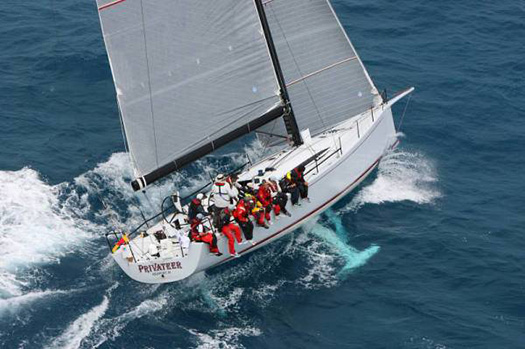
Privateer is one of the evergreen Cookson 50s, which have been consistently successful in the world's top offshore races for a decade
But as 2013's results show, doing well in the Sydney-Hobart has a huge element of horses for courses to it, and in 2010 the very new First 40 from Beneteau made a prodigious debut by taking first and second overall. They're still a very competitive boat, so not surprisingly there's five of them shaping up for the race to Hobart, and this is where the most direct Irish involvement comes, as Barry Hurley and his team have linked up with co-owner Mathew Vadas to put the beef in the crew of the First 40 Breakthrough. [Click to read Barry Hurley's preparations for this third successive Sydney–Hobart Race – Ed]
The same linkup saw Breakthrough take eighth in Class and 29th Overall in the 2013 race, but this time round Barry Hurley ships on board with the added experience of second overall and first in class in October's Middle Sea Race. With him to show that the boat is indeed sailing under the Dublin Bay Sailing Club colours are Catherine Halpin and Kenny and Alexander Rumball. And the word on the waterfront is that a shore support team not entirely unconnected with the Irish National Sailing School will be an enthusiastic presence in Sydney on December 26th. We look forward to hearing from them. Meanwhile, Happy Christmas everyone.
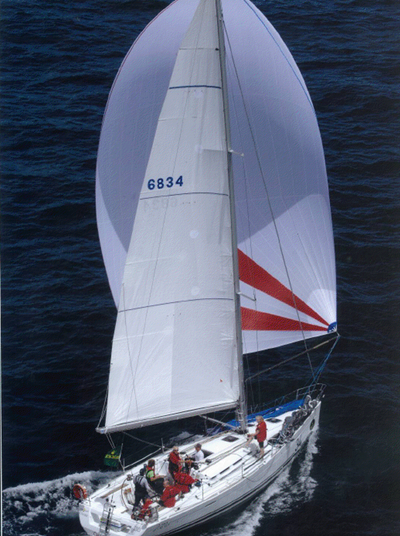
The First 40 Breakthrough will be racing under Dublin Bay Sailing Club colours in the Rolex Sydney-Hobart race 2014, starting December 26th
Fleet Arrives in Hobart
Sean Langman and Anthony Bell's 100-foot super maxi Investec Loyal was the second yacht across the finish line of the Rolex Sydney Hobart Yacht Race, arriving last night just after midnight, three and a half hours behind the provisional line honours winner and race favourite Wild Oats XI.
Investec Loyal's sailing time to Hobart was two days, eleven hours and eleven minutes.
The yacht was on track to finish sooner; however as is often the case when arriving at the mouth of the Derwent River after dark, the breeze typically drops right off.
This was Langman's 20th Rolex Sydney Hobart race. Once across the line he congratulated the Wild Oats XI crew on being first to Hobart, only a few hours before. Asked whether he can challenge Bob Oatley's super maxi Wild Oats XI again and win, he responded, "definitely, there is more in this boat, more in the team."
"The first afternoon we were the faster boat, they were a slicker team. We'll change [that] though," Langman warned. "We sailed a seamanship race."
Later Wednesday morning, four more contenders crossed the finish line in Hobart: Lahana, Ichi Ban, Wild Thing and Rán.
The 30-meter fixed keel water ballasted Lahana, skippered by Peter Millard, completed the gruelling race in two days, fourteen hours, and nine minutes. Lahana arrived at the finish line at 3:09am 29 December. Like Investec Loyal crossing the finish line was frustrating as the winds on the Derwent River were all but gone.
The story was similar for Matt Allen's Jones 70 Ichi Ban. Allen and his crew sailed an inspiring race. The whole way they had been in the breakaway pack of four leading yachts, snapping at the sterns of their much bigger rivals and ahead of the remaining super maxi Wild Thing and the 72-foot mini-maxi Rán.
"Up to 2300 last night we had great running conditions. Our approach to Tasman Island was in a good northerly breeze," Allen said when he finally stepped onto Hobart's Constitution Dock after finishing at 0552 Wednesday morning.
"The breeze was still reasonable to Tasman Light, but then it got light at Cape Raoul. It picked up a bit later, but when we got to the Iron Pot it fell apart. There was no wind anywhere on the Derwent River. It didn't matter where you were on the River, there was nothing." Ichi Ban, veteran of five previous Rolex Sydney Hobarts, completed the race in a respectable two days, 16 hours and 52 minutes.
Grant Wharington's Wild Thing finished 23 minutes behind Ichi Ban at 0615 Wednesday morning while Zennstrom's Rán arrived seven minutes later at 0622.
Like Wild Oats XI, Rán also faces the same protest about the use of its radio from the event Race Committee. The International Jury will hear the protest at 1300 today at the Royal Yacht Club Tasmania.
This was Zennstrom's second Rolex Sydney Hobart Race. Commenting on the race conditions they encountered this year Zennstrom said, "I think I have now definitely seen what the race is all about. It was tough crossing Bass Strait; 35 knots of wind and big seas. The whole experience has been fantastic."
At 1030 Wednesday, saw the arrival of Alan Brierty's Reichel/Pugh Limit and less than three minutes later, Stephen Ainsworth's Loki. Both boats were locked in a dead heat for most of the race. According to Limit's owner Alan Brierty, "First Loki got in front, then we got in front. It was back and forth. We finally got in front and stayed in front at Tasman Light. Speaking of the neck-and-neck battle with Loki, Brierty said, "It was a race within the race. For us, it was the race."
Stephen Ainsworth reflected about coming in behind Limit, "We had done everything right. Limit just got away and we couldn't catch them. He then jokingly said, "After a while we thought, we hate this race."
Asked how this Rolex Sydney Hobart race compared with others, tactician and former America's Cup competitor Chris Dickson, tactician onboard Limit reflected, "This race wasn't any better or worst than any other Hobart. We still saw 45 knots of breeze, big breaking waves—it's just the Bass Strait."
Most of the race fleet is across the Bass Strait and is spread out along the eastern Tasmanian coast. Their race is far from over as tacticians will be working hard to navigate through a very large area of light and variable breeze along the coast, in the shadow of the island.
Race organisers announced the 17th retirement, Matthew Prentice's Archambault 40 Nautical Circle, which dropped out with engine problems and was headed to Eden.
Nine yachts have finished, with 61 yachts still racing. Still up for grabs is the Tattersall's Cup for the overall handicap win. Currently leading is Darryl Hodgkinson's Beneteau 45, Victoire, which would need to finish by 0736 tomorrow (Dec 30).
The entries for this the 66th edition of the Rolex Sydney Hobart Yacht Race included six international entries from the USA, UK, Italy, France, as well as two partly crewed Russian boats, and entries from seven of the eight Australian states and territories.
Race Tracker: Race enthusiasts can go to http://rolexsydneyhobart.com/yacht_tracker.asp for a real time tracker of yachts and their position.
Official race website: www.rolexsydneyhobart.com




























